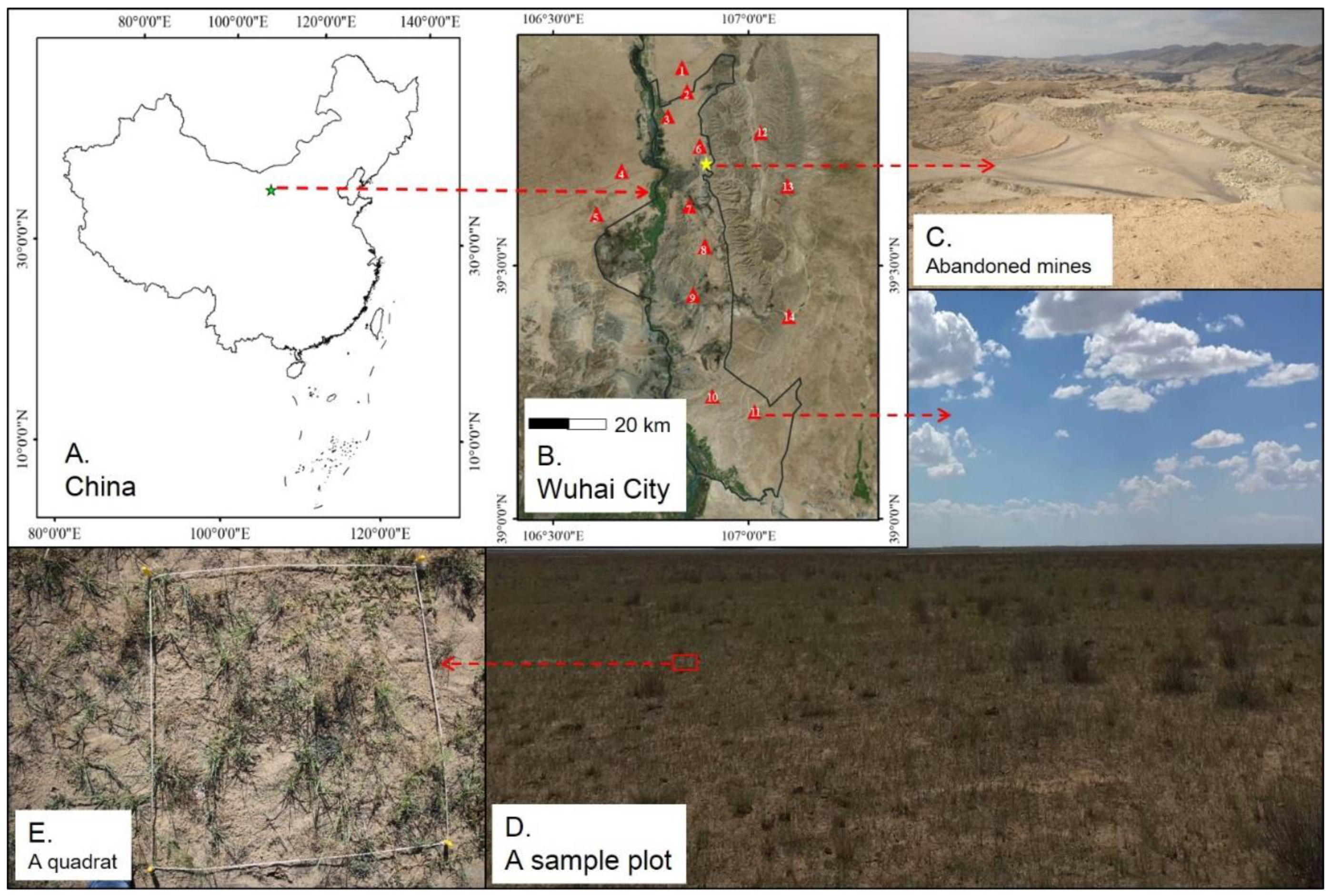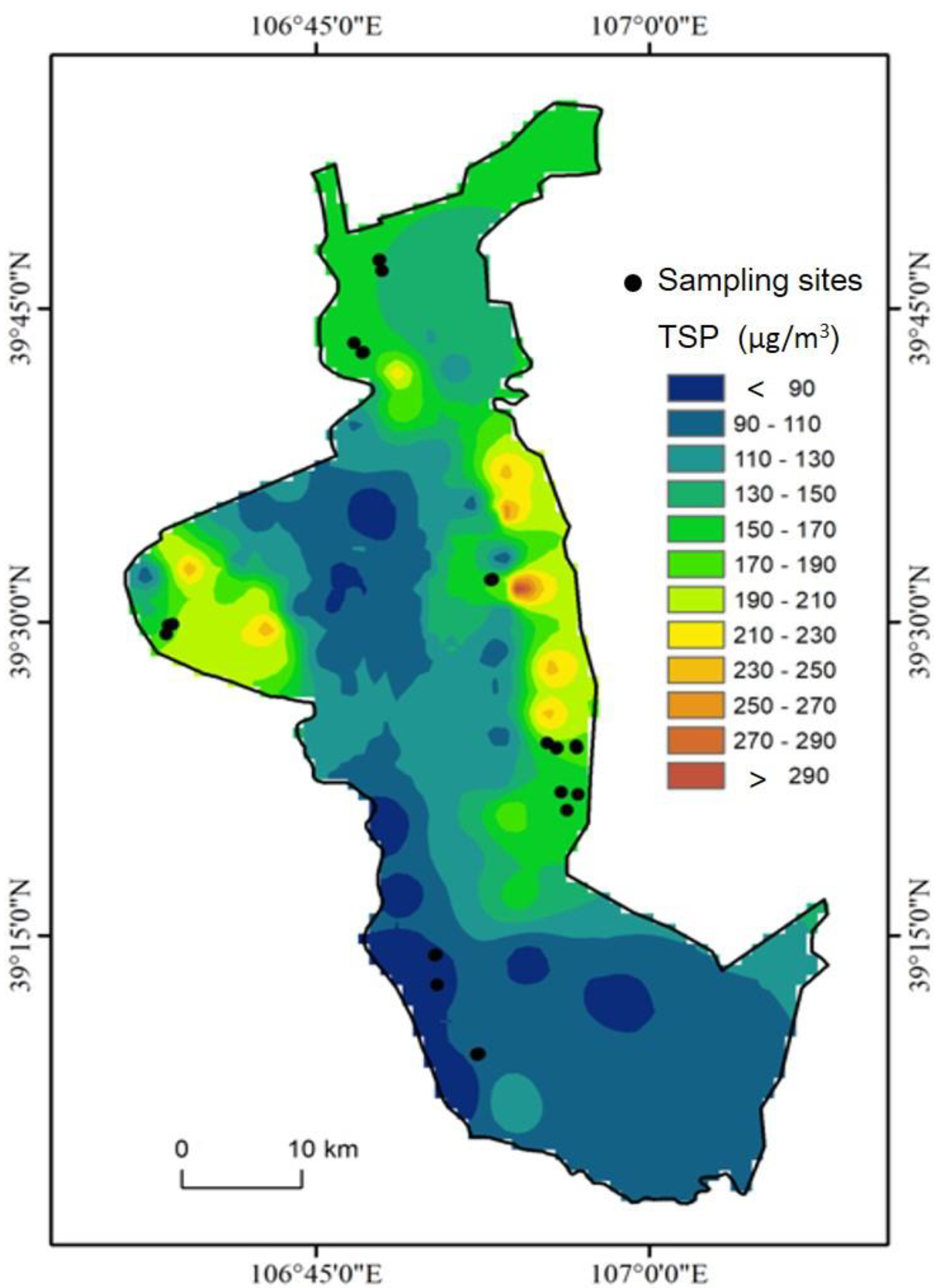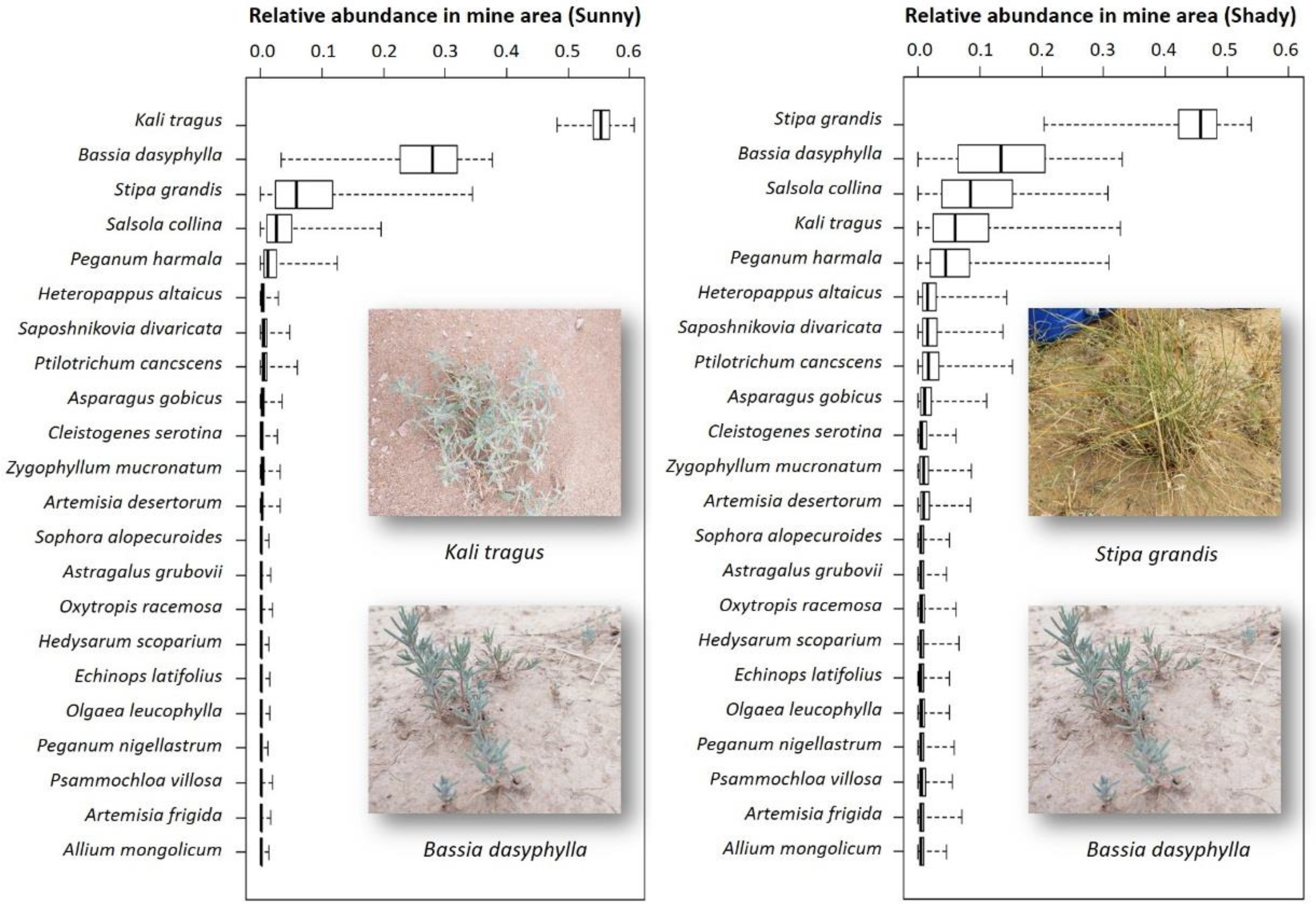Applying Trait-Based Modeling to Achieve Functional Targets during the Ecological Restoration of an Arid Mine Area
Abstract
1. Introduction
2. Materials and Methods
2.1. Study Area
2.2. Plots Selection
2.3. Vegetation Investigation
2.4. Soil Sampling
2.5. Total Suspended Particulate Matter (TSP) Concentration Monitoring
2.6. Data Analysis
2.6.1. Correction of Dust Retention by Plant Leaves
2.6.2. Calculation of Community-Weighted Mean (CWM)
2.6.3. Linear Model Fitting
2.6.4. CATS Model
3. Results
3.1. Plant Distribution
3.2. Plant Functional Traits
3.3. Concentration Characteristics of Total Suspended Particulate Matter
3.4. Soil Factors
3.5. Linear Model Relating CWMs and Environmental Factors
3.6. Fitting Results of CATS Model
4. Discussion
4.1. Relationships between Plants and Environmental Factors
4.2. Prediction of Relative Abundance of Species Based on CATS Model
4.3. Achieve Appropriate Ecological Restoration Based on Response-Effect Trait Framing
5. Conclusions
Author Contributions
Funding
Institutional Review Board Statement
Informed Consent Statement
Data Availability Statement
Acknowledgments
Conflicts of Interest
References
- Zhang, H.Y.; Jiang, C.; Wang, Y.X.; Wang, J.; Li, C.F.; Yang, Z.Y.; Gong, Q.H.; Yang, C.L. Improving the integrated efficacy of ecosystem restoration efforts by linking land degradation neutrality to ecosystem service enhancement from a spatial association perspective. Ecol. Eng. 2022, 181, 106693A. [Google Scholar] [CrossRef]
- Akturk, E.; Guneroglu, N. Degradation of coastal ecosystem services in southern Black Sea: A case study of Trabzon city. Ocean. Coast Manag. 2021, 213, 105837. [Google Scholar] [CrossRef]
- Desta, H. Local perceptions of ecosystem services and human-induced degradation of lake Ziway in the Rift Valley region of Ethiopia. Ecol. Indic. 2021, 127, 105837. [Google Scholar] [CrossRef]
- Laughlin, D.C. Applying trait-based models to achieve functional targets for theory-driven ecological restoration. Ecol. Lett. 2014, 17, 771–784. [Google Scholar] [CrossRef] [PubMed]
- Jeon, B.; Jeong, H.; Choi, S.; Jeon, S. Assessment of Subsidence Hazard in Abandoned Mine Area Using Strength Reduction Method. Ksce. J. Civ. Eng. 2022, 26, 4338–4358. [Google Scholar] [CrossRef]
- Ona, M.B.; Goberna, M.; Navarro-Cano, J.A. Natural Seed Limitation and Effectiveness of Forest Plantations to Restore Semiarid Abandoned Metal Mining Areas in SE Spain. Forests 2021, 12, 548. [Google Scholar] [CrossRef]
- Alaira, S.A.; Padilla, C.S.; Alcantara, E.L.; Aggangan, N.S. Social Acceptability of the Bioremediation Technology for the Rehabilitation of an Abandoned Mined-Out Area in Mogpog, Marinduque, Philippines. J. Env. Sci. Manag. 2021, 24, 77–91. [Google Scholar] [CrossRef]
- Hou, J.; Yang, J.; Tan, J. A new method for revealing spatial relationships between shrubs and soil resources in arid regions. Catena 2019, 183, 104187. [Google Scholar] [CrossRef]
- Islam, N.; Saikia, B.K. An overview on atmospheric carbonaceous particulate matter into carbon nanomaterials: A new approach for air pollution mitigation. Chemosphere 2022, 303, 135027. [Google Scholar] [CrossRef]
- Feng, R.; Zheng, H.J. Evidence for regional heterogeneous atmospheric particulate matter distribution in China: Implications for air pollution control. Environ. Chem. Lett. 2019, 17, 1839–1847. [Google Scholar] [CrossRef]
- Damigos, D.; Kaliampakos, D. Assessing the benefits of reclaiming urban quarries: A CVM analysis. Landsc. Urban Plan 2003, 64, 249–258. [Google Scholar] [CrossRef]
- Laughlin, D.C.; Strahan, R.T.; Huffman, D.W.; Sánchez Meador, A.J. Using trait-based ecology to restore resilient ecosystems: Historical conditions and the future of montane forests in western North America. Restor. Ecol. 2017, 25, S135–S146. [Google Scholar] [CrossRef]
- Laughlin, D.C.; Joshi, C.; van Bodegom, P.M.; Bastow, Z.A.; Fule, P.Z. A predictive model of community assembly that incorporates intraspecific trait variation. Ecol. Lett. 2012, 15, 1291–1299. [Google Scholar] [CrossRef] [PubMed]
- Laughlin, D.C.; Laughlin, D.E. Advances in modeling trait-based plant community assembly. Trends Plant Sci. 2013, 18, 584–593. [Google Scholar] [CrossRef] [PubMed]
- Mensens, C.; De Laender, F.; Janssen, C.R.; Sabbe, K.; De Troch, M. Different response-effect trait relationships underlie contrasting responses to two chemical stressors. J. Ecol. 2017, 105, 1598–1609. [Google Scholar] [CrossRef]
- Leps, J.; de Bello, F.; Lavorel, S.; Berman, S. Quantifying and interpreting functional diversity of natural communities: Practical considerations matter. Preslia 2006, 78, 481–501. [Google Scholar]
- Violle, C.; Navas, M.-L.; Vile, D.; Kazakou, E.; Fortunel, C.; Hummel, I.; Garnier, E. Let the concept of trait be functional! Oikos 2007, 116, 882–892. [Google Scholar] [CrossRef]
- Suding, K.N.; Lavorel, S.; Chapin, F.S.; Cornelissen, J.H.C.; DÍAz, S.; Garnier, E.; Goldberg, D.; Hooper, D.U.; Jackson, S.T.; Navas, M.-L. Scaling environmental change through the community-level: A trait-based response-and-effect framework for plants. Glob. Change Biol. 2008, 14, 1125–1140. [Google Scholar] [CrossRef]
- Lavorel, S.; Garnier, E. Predicting changes in community composition and ecosystem functioning from plant traits: Revisiting the Holy Grail. Funct. Ecol. 2002, 16, 545–556. [Google Scholar] [CrossRef]
- Ma, Z.; Guo, D.; Xu, X.; Lu, M.; Bardgett, R.D.; Eissenstat, D.M.; McCormack, M.L.; Hedin, L.O. Evolutionary history resolves global organization of root functional traits. Nature 2018, 555, 94–97. [Google Scholar] [CrossRef]
- Keenan, T.F.; Niinemets, Ü. Global leaf trait estimates biased due to plasticity in the shade. Nat. Plants 2016, 3, 1–6. [Google Scholar] [CrossRef] [PubMed]
- Wright, I.J.; Dong, N.; Maire, V.; Prentice, I.C.; Westoby, M.; Diaz, S.; Gallagher, R.V.; Jacobs, B.F.; Kooyman, R.; Law, E.A.; et al. Global climatic drivers of leaf size. Science 2017, 357, 917–921. [Google Scholar] [CrossRef] [PubMed]
- Butler, E.E.; Datta, A.; Flores-Moreno, H.; Chen, M.; Wythers, K.R.; Fazayeli, F.; Banerjee, A.; Atkin, O.K.; Kattge, J.; Amiaud, B.; et al. Mapping local and global variability in plant trait distributions. Proc. Natl. Acad. Sci. USA 2017, 114, E10937–E10946. [Google Scholar] [CrossRef] [PubMed]
- Gross, N.; Bagousse-Pinguet, Y.L.; Liancourt, P.; Berdugo, M.; Gotelli, N.J.; Maestre, F.T. Functional trait diversity maximizes ecosystem multifunctionality. Nat. Ecol. Evol. 2017, 1, 1300–1302. [Google Scholar] [CrossRef]
- Kunstler, G.; Falster, D.; Coomes, D.A.; Hui, F.; Kooyman, R.M.; Laughlin, D.C.; Poorter, L.; Vanderwel, M.; Vieilledent, G.; Wright, S.J.; et al. Plant functional traits have globally consistent effects on competition. Nature 2016, 529, 204–207. [Google Scholar] [CrossRef]
- Wang, W.F.; Hao, W.D.; Sian, Z.F.; Lei, S.G.; Wang, X.S.; Sang, S.X.; Xu, S.C. Effect of coal mining activities on the environment of Tetraena mongolica in Wuhai, Inner Mongolia, China—A geochemical perspective. Int. J. Coal. Geol. 2014, 132, 94–102. [Google Scholar] [CrossRef]
- Rodríguez, A.; Durán, J.; Fernández-Palacios, J.M.; Gallardo, A. Spatial pattern and scale of soil N and P fractions under the influence of a leguminous shrub in a Pinus canariensis forest. Geoderma 2009, 151, 303–310. [Google Scholar] [CrossRef]
- Hirobe, M.; Koba, K.; Tokuchi, N. Dynamics of the internal soil nitrogen cycles under moder and mull forest floor types on a slope in a Cryptomeria japonica D. Don plantation. Ecol. Res. 2003, 18, 53–64. [Google Scholar] [CrossRef]
- Swetnam, T.W.; Allen, C.D.; Betancourt, J.L. Applied historical ecology: Using the past to manage for the future. Ecol. Appl. 1999, 9, 1189–1206. [Google Scholar] [CrossRef]
- Zhang, Y.; Yang, J.Y.; Wu, H.L.; Shi, C.Q.; Zhang, C.L.; Li, D.X.; Feng, M.M. Dynamic changes in soil and vegetation during varying ecological-recovery conditions of abandoned mines in Beijing. Ecol. Eng. 2014, 73, 676–683. [Google Scholar] [CrossRef]
- Liu, N.; Tian, Q.; Zhang, W. Comparison of adaptive strategies to phosphorus-deficient soil between dominant species Artemisia frigida and Stipa krylovii in typical steppe of Nei Mongol. Chin. J. Plant Ecol. 2014, 38, 905–915. [Google Scholar]
- Ren, J.; Zhao, C.; Zhao, X.; Ma, J.; Li, Z.; Gou, F. Fractal characteristics of Agriophyllum squarrosum roots in desert-oasis ecotone in Jinta County, Gansu Province. Acta Ecol. Sin. 2020, 40, 5298–5305. [Google Scholar]
- Li, C.; Ma, J.; Li, Y.; Fan, L. Effects of pH value on the morphological features and activity of roots of three life-form plant species. Arid Zone Res. 2010, 27, 915–920. [Google Scholar]
- Grammatikopoulus, G.; Manetas, Y. Direct absorption of water by hairy leaves of Phlomis fruticosaand its contribution to drought avoidance. Can. J. Bot. 1994, 72, 1805–1811. [Google Scholar] [CrossRef]
- Johnson, H.B. Plant pubescence: An ecological perspective. Bot. Rev. 1975, 41, 233–258. [Google Scholar] [CrossRef]
- Zhuang, Y.; Zhao, W. Experimental Study of Effects of Artificial Dew on Bassia dasyphylla and Agriophyllum squarrosum. J. Desert Res. 2010, 30, 1068–1074. [Google Scholar]





| Sample Plot | Vegetation Coverage (%) | Species Richness | Soil Total Nitrogen (g/kg) | Soil Total Phosphorus (g/kg) | Soil Water Content (%) |
|---|---|---|---|---|---|
| Mine area (sunny) | — | — | 0.40 | 0.17 | 3.03 |
| Mine area (shady) | — | — | 0.39 | 0.21 | 4.50 |
| 1 | 34.6 | 2 | 0.16 | 0.17 | 2.34 |
| 2 | 27.3 | 4 | 0.20 | 0.27 | 3.20 |
| 3 | 25.2 | 5 | 0.28 | 0.26 | 2.66 |
| 4 | 54.7 | 1 | 0.13 | 0.16 | 1.42 |
| 5 | 67.4 | 2 | 0.25 | 0.23 | 1.72 |
| 6 | 29.4 | 4 | 0.42 | 0.36 | 4.53 |
| 7 | 76.8 | 7 | 0.55 | 0.39 | 7.63 |
| 8 | 68.1 | 8 | 0.40 | 0.33 | 6.12 |
| 9 | 44.9 | 6 | 0.58 | 0.28 | 8.19 |
| 10 | 25.5 | 3 | 0.23 | 0.21 | 2.98 |
| 11 | 28.3 | 2 | 0.27 | 0.21 | 2.94 |
| 12 | 43.9 | 4 | 0.30 | 0.35 | 3.38 |
| 13 | 39.1 | 4 | 0.30 | 0.36 | 4.27 |
| 14 | 41.6 | 3 | 0.36 | 0.35 | 3.56 |
| DR (g/m2) | SLA (cm2/g) | LDMC (g/g) | RL (cm) | RSA (cm2) | RD (mm) | RV (cm3) | |
|---|---|---|---|---|---|---|---|
| CWM aim in sunny area | 14.80 | 37.07 | 0.34 | 59.91 | 22.07 | 0.40 | 0.11 |
| CWM aim in shady area | 15.90 | 43.15 | 0.29 | 89.88 | 22.82 | 0.40 | 0.22 |
| Allium mongolicum | 1.81 | 56.94 | 0.28 | 60.35 | 20.82 | 1.10 | 0.57 |
| Artemisia desertorum | 2.45 | 23.73 | 0.26 | 120.95 | 64.55 | 1.70 | 2.74 |
| Artemisia frigida | 6.94 | 35.81 | 0.28 | 200.14 | 34.14 | 0.54 | 0.46 |
| Asparagus gobicus | 1.29 | 18.36 | 0.47 | 47.59 | 5.67 | 0.38 | 0.05 |
| Astragalus grubovii | 1.74 | 42.53 | 0.34 | 59.33 | 12.75 | 0.68 | 0.22 |
| Bassia dasyphylla | 17.79 | 61.76 | 0.21 | 131.14 | 14.79 | 0.36 | 0.13 |
| Cleistogenes serotina | 7.34 | 44.74 | 0.34 | 186.30 | 12.46 | 0.21 | 0.07 |
| Echinops latifolius | 4.09 | 31.13 | 0.39 | 65.21 | 8.98 | 0.44 | 0.10 |
| Hedysarum scoparium | 3.07 | 29.87 | 0.38 | 102.69 | 16.97 | 0.53 | 0.22 |
| Heteropappus altaicus | 5.48 | 46.79 | 0.24 | 279.81 | 52.60 | 0.60 | 0.79 |
| Kali tragus | 9.54 | 72.01 | 0.22 | 60.03 | 14.11 | 0.75 | 0.26 |
| Olgaea leucophylla | 5.26 | 59.12 | 0.25 | 17.10 | 17.05 | 3.17 | 1.35 |
| Oxytropis racemosa | 6.39 | 76.28 | 0.25 | 88.80 | 17.36 | 0.62 | 0.27 |
| Peganum harmala | 3.84 | 21.69 | 0.41 | 59.33 | 22.24 | 1.19 | 0.66 |
| Peganum nigellastrum | 1.34 | 45.62 | 0.21 | 92.07 | 24.90 | 0.86 | 0.54 |
| Psammochloa villosa | 0.47 | 32.19 | 0.37 | 54.74 | 51.34 | 2.99 | 3.83 |
| Ptilotrichum cancscens | 3.84 | 55.86 | 0.29 | 61.37 | 40.60 | 2.11 | 2.14 |
| Salsola collina | 18.03 | 32.26 | 0.22 | 172.76 | 22.87 | 0.42 | 0.24 |
| Saposhnikovia divaricata | 6.17 | 57.49 | 0.23 | 9.00 | 22.77 | 8.05 | 4.58 |
| Sophora alopecuroides | 7.35 | 41.66 | 0.28 | 78.52 | 28.10 | 1.14 | 0.80 |
| Stipa grandis | 2.56 | 22.26 | 0.43 | 38.87 | 6.43 | 0.53 | 0.09 |
| Zygophyllum mucronatum | 7.13 | 45.58 | 0.27 | 50.79 | 11.70 | 0.73 | 0.22 |
Publisher’s Note: MDPI stays neutral with regard to jurisdictional claims in published maps and institutional affiliations. |
© 2022 by the authors. Licensee MDPI, Basel, Switzerland. This article is an open access article distributed under the terms and conditions of the Creative Commons Attribution (CC BY) license (https://creativecommons.org/licenses/by/4.0/).
Share and Cite
Hou, J.; Wu, M.; Feng, H. Applying Trait-Based Modeling to Achieve Functional Targets during the Ecological Restoration of an Arid Mine Area. Agronomy 2022, 12, 2833. https://doi.org/10.3390/agronomy12112833
Hou J, Wu M, Feng H. Applying Trait-Based Modeling to Achieve Functional Targets during the Ecological Restoration of an Arid Mine Area. Agronomy. 2022; 12(11):2833. https://doi.org/10.3390/agronomy12112833
Chicago/Turabian StyleHou, Jian, Menghan Wu, and Haobo Feng. 2022. "Applying Trait-Based Modeling to Achieve Functional Targets during the Ecological Restoration of an Arid Mine Area" Agronomy 12, no. 11: 2833. https://doi.org/10.3390/agronomy12112833
APA StyleHou, J., Wu, M., & Feng, H. (2022). Applying Trait-Based Modeling to Achieve Functional Targets during the Ecological Restoration of an Arid Mine Area. Agronomy, 12(11), 2833. https://doi.org/10.3390/agronomy12112833






